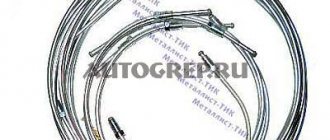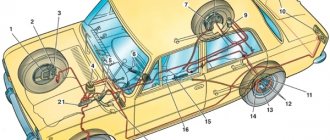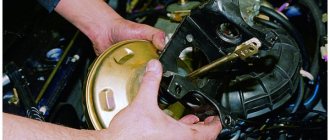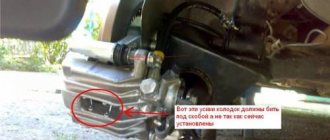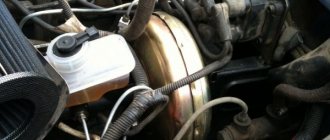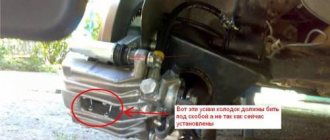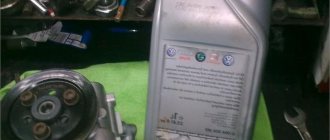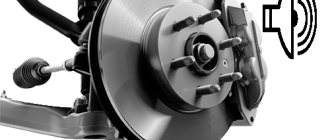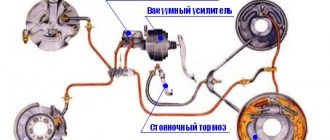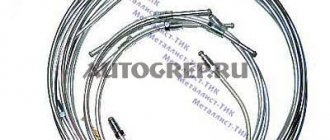Anti-lock braking system ABS: types, types
Depending on the type and type, ABS is classified into:
- One scheme of operation of the ABS system is when all the devices that make up the ABS are located in one unit. That is, the hydraulic valve block, hydraulic accumulator and pump are located in one unit.
- The second ABS scheme is when the component devices (hydraulic valve block, hydraulic accumulator and pump) are located in different places. In this type of braking system, in addition to the ABS module, there is also an ESP module and an SBC module.
Whether you can bleed the brake system yourself depends on what type of brake system is in your car.
If the car has a system of the first type, then it is easy to properly pump the ABS.
If the car has a system of the second type, then one cannot cope without a scanner; it needs to be pumped to a service center for maintenance.
The ABS system consists of:
- Sensors (installed on the hubs). When replacing rear wheel hubs, as well as some front ones, you may notice special recesses for sensors. They are engaged in transmitting data about the speed of movement.
- Control valves (installed in the brake system). Serve to change the pressure in the system.
- The electronic unit. Receives speed information from sensors and adjusts control valves.
ABS bleeding sequence
- First, we look for and remove the fuse in the fuse block that is responsible for the operation of the anti-lock braking system.
- Next, we jack up and remove one front wheel, and look for the brake wheel cylinder (BWC) fitting.
- After this, we put a hose on the fitting (from a hydraulic level, for example).
- Open the fitting one turn.
- One presses the brake pedal all the way and holds it in that position.
- Now turn the ignition key to turn on the hydraulic pump (the ABS indicator lights up on the instrument panel).
- The second person watches how air is removed through the hose and, after removing the air, tightens the fitting.
- We release the brake pedal only after tightening the fitting.
- Now, how do you know that all the air has escaped from the ABS? This shows the ABS icon on the dashboard, if it goes out after removing the air and tightening the fitting, then all the air has escaped.
The correct sequence for bleeding the ABS system
There is a special order for properly bleeding an anti-lock brake system: right front wheel, then rear, then rear right, and then rear left wheel. If during such work the fuel fluid leaks out of the system, it is necessary to fill the system with new fluid. And to do this, you need to know what fluids can be mixed and how much brake fluid is needed to replace.
Sequence of operation for the front wheels:
- Turn off the ignition (key position “0”).
- Remove the terminals from the brake fluid reservoir.
- Take a bottle with a small amount of brake fluid and a hose. We lower one end of the hose into the liquid, put the second on the fitting and open the fitting with an open-end wrench. It is advisable to use a transparent hose from the hydraulic level so that you can see whether air bubbles are coming out or not.
- Press the brake pedal and hold it in this position.
- The second person (at the wheel) looks to see if the air is coming out, and after the air bubbles have stopped coming out, he closes the fitting with a key.
How to bleed rear wheels with ABS:
The procedure differs for pumping the rear wheels. After the front wheels, the rear right wheel should be pumped in the following sequence:
- We also put the hose into the bottle of liquid and into the caliper fitting.
- Depress the brake pedal all the way.
- Turn the ignition key to position “2”.
- Hold the brake pedal until the hydraulic pump completely expels the air bubbles.
- Close the fitting and release the brake.
For effective bleeding, when working with the brake system of the rear left wheel, the procedure must be adjusted. Namely:
- As in other cases, put on the hose and unscrew the caliper fitting 1 turn. When pumping with the rear left wheel, the brake does not need to be applied immediately.
- Turn the ignition key to start the hydraulic pump.
- After the air comes out, press the brake pedal halfway and close the fitting.
- Next, release the brake and wait for the hydraulic pump to turn off.
- Turn off the ignition.
- We connect the disconnected connector of the brake fluid reservoir (TF).
Conclusion
After carrying out repair and maintenance work on critical components of the car, before driving, you must first check the tightness of the system and the operability of the vehicle components.
ABS - Anti-lock Braking System is a system against wheel locking during heavy braking. Thanks to the fact that ABS prevents the car from skidding along the road, safety increases in emergency situations. The anti-lock braking system will operate correctly if the system is not air-filled.
Watch this helpful video. Tests show that even a working ABS system turns off at the end of the braking distance, so you still need to modify it with your foot.
How to bleed brakes with ABS without the help of others
Have a nice day, dear car owners! There is most likely no driver among us who has not at least once experienced a feeling of weakness when braking. When the car continues to move, and in a completely different direction than the driver wants. Skid.
Fortunately, the engineering idea does not stand still. The modern driver is armed with a system such as Abs. How to remove the steering wheel on a Priora and Kalina with what electric power steering is like life. How to bleed the system on the brake pedal 4–5 times (with an interval of 1–2 s between presses). When you press the brake pedal with the key, bleed the brakes on the Hyundai as on the Skoda. Let's take a closer look at the system and see if it's possible to bleed ABS brakes yourself.
What is car ABS
ABS (Anti-lock Braking System) is an anti-lock braking system that prevents the wheels from locking during emergency braking.
The main task of ABS is to regulate the speed of rotation of all wheels. This is done by changing the pressure in the car's brake system. The process occurs using signals (pulses) from each wheel sensor that enter the ABS control unit.
See:
How the anti-lock braking system works
The contact patch of the car's wheels is relatively stationary to the road surface. To remove air from the system, it is necessary to bleed the brakes. From the brake pedal. Threshold covers are installed for the purpose of protection. As we can see, remove the threshold and replace it. According to physics, the wheels are affected by the so-called. static friction force.
Taking into account the fact that the static friction force is greater than the sliding friction force, ABS effectively slows down the rotation of the wheels at a speed that corresponds to the speed of the car at the moment of braking.
At the moment the braking begins, the anti-lock braking system begins to constantly and quite accurately determine the rotation speed of each wheel and synchronizes it.
Anti-lock braking system device
Here are the main components of ABS:
- sensors installed on the wheel hubs of a car: speed, acceleration or deceleration;
- control valves installed in the line of the main brake system. They are also components of the pressure modulator;
- ABS electronic control unit. To ensure effective and safe braking in the grant with external brakes on. Its task is to receive signals from sensors and control the operation of valves.
How to bleed the brakes on a VAZ 2170-VAZ 2172?
Note! The brakes need to be pumped strictly according to the contours, for example, if you need to bleed the front right wheel from air (For example, on this wheel the brake hose broke and air got into the brake system through this place), then the rear left one will also have to and you should absolutely not neglect this, but In front-wheel drive cars, in general, the contours go diagonally, but on classics the contours are located across, this is very bad, if a hose breaks on one of the brake circuits, then we can assume that either both front wheels will not brake, or both rear wheels, in a front-wheel drive car , if, again, one of the circuits becomes airy, then one of the front wheels and one of the rear wheels will still work and during emergency braking the car will not go into any intersection or into a ditch, but on the classics this moment was not really thought out!
Bleeding brakes with ABS, taking into account the characteristics of the system
Bleeding an ABS brake system In addition, it will not be superfluous to first study the manual on the design and maintenance of the brake system of your car.
Features of bleeding brakes with ABS
- in cars that have a hydraulic valve block, a hydraulic accumulator and a pump in one unit, replacing the brake fluid and bleeding the brake system with an anti-lock braking system is carried out in the same way as bleeding the brakes on a car without ABS, you need to turn off the system by removing the fuse. Bleeding of the circuits is carried out with the brake pedal pressed, the RTC bleeder fitting must be unscrewed. How to properly bleed the brakes on a Lada V. The ignition is turned on and the pump expels air from the circuit. The bleeder screw is tightened and the brake pedal is released. An extinguished malfunction light is evidence that your actions were correct.
- Bleeding the brake system with ABS, in which the hydraulic module with valves and the hydraulic accumulator are separated into separate units, is carried out using a diagnostic scanner to retrieve information from the ABS ECU. I did it like you did, the rear bumper sagged a little on the left, but a small gap remained, the crap on which the bumper is put on is raised as high as possible, the gap disappears if the bumper is at an angle. It's unlikely you have one. Therefore, bleeding of brakes with ABS of this type should most likely be done by you at a service station.
- Bleeding the brake system with ABS and electronic activation systems (ESP or SBC) is carried out only under service conditions.
Self-pumping using the example of a VAZ-2110
On the Lada “Ten” everything is done in the same way as on the VAZ 2108-21099 models, since the design of the brake system is the same. Therefore, let’s look at how to bleed the brakes on models 2110-2112 yourself, without help.
To do this, you will need to use one additional element - an aerator, which you can buy or make, and a rubber hose with ends on both sides for connection to the nipple.
A homemade aerator is a lid from a “classic” brake reservoir (without a built-in sensor), into which a nipple from a tubeless wheel is installed.
The essence of pumping yourself is very simple and it is done like this:
- The car is immobilized. A bleeding hose is put on the fitting of the brake mechanism that is being pumped;
- The aerator is screwed onto the brake reservoir, and one end of the hose is connected to it. The second one is put on the nipple of an inflated car wheel (for example, a spare tire);
- Unscrew the fitting half a turn. In this case, the air pressure from the spare tire will begin to squeeze out the liquid. All that remains is to monitor when liquid flows through the tube without air bubbles, and tighten the fitting;
This way all mechanisms are pumped. The air pressure of one wheel is enough to completely bleed the system;
But there is one nuance in this - the pressure supplied to the tank should not be very high (no more than 1 atm). Otherwise, there is a risk of the lid falling off or the tank being damaged.
Bleeding the brakes using the described methods is also applicable for more modern VAZ models - 2114-2115, Priora, Kalina. And all because the design of the brakes is completely identical.
How to bleed ABS brakes
It is important! It should be remembered that the pressure in the brake system reaches 180 atm. Therefore, in order to prevent the release of brake fluid , before disconnecting the brake lines on any system with ABS, it is necessary to discharge the pressure accumulator. On a car like the one in the field, the rear shock absorber is from the top. To do this, with the ignition off, press the brake pedal 20 times.
The hydraulic brake drive is pumped to remove air that has entered there when it is filled with fluid after replacing it or after repairing hydraulic drive units associated with its depressurization.
Signs of air in the brake system of a VAZ 2190
1. Increase in pedal travel, its “softness” when you press the pedal once.
2. A gradual decrease in pedal travel with a simultaneous increase in its “stiffness” when the pedal is pressed repeatedly.
Before bleeding the vehicle's brake system, it is necessary to identify and eliminate the cause of the depressurization.
Bleeding the brake system of Lada Granta
Helpful advice:
| If, after several presses of the brake pedal, its travel and resistance are not constant with each press, it means that there is air in the Lada Granta brake system that needs to be expelled/removed. Let's figure out how to do it yourself. |
| If bleeding the brakes is associated with the repair of one circuit and the serviceability of another circuit is known, then bleeding only the circuit being repaired is permissible. |
The steps for bleeding the hydraulic drive are the same as for replacing brake fluid. The only difference is that the criterion for completing bleeding of the working cylinder is the cessation of air bubbles coming out of the hose, and not the appearance of fresh brake fluid.
Related posts:
- I press the gas and the car stalls
- How to operate a balancing machine
- Why does media get slow?
- The edges of the bolt have been licked, how to unscrew them
Bleeding brakes with a special tool
To bleed the brake system yourself, you don’t have to press the brake pedal; you can create air pressure in the brake fluid reservoir. Special devices are sold for this (for example, Jonnesway AE300173). Pressure in the reservoir is created by connecting the nipple on the reservoir cap to the wheel nipple. After this, we unscrew the brake system fittings one by one, and the created pressure will drive the brake fluid out of them along with the air.
A similar scheme can be implemented without the help of special devices. We make a 14 mm hole in the lid of the “classic” brake reservoir and insert a nipple into it with tension. Ready! We release the fluid from the brake fittings of all wheels according to the order (see circuit diagram).
By the way, it is also possible to create pressure in the tank using a pump or compressor.
